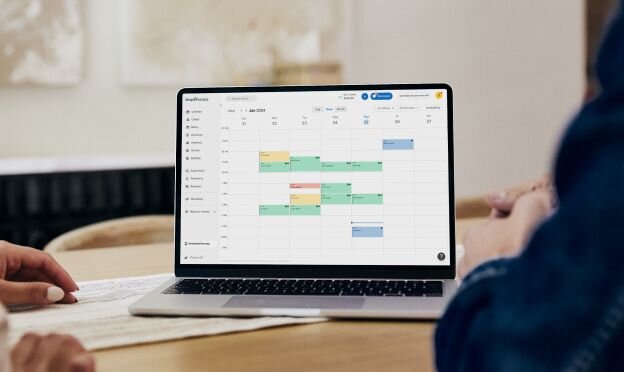Communication styles worksheet
Get the free communication styles worksheet
Download free resource
Enter your email below to access this resource.
By entering your email address, you are opting-in to receive emails from SimplePractice on its various products, solutions, and/or offerings. Unsubscribe anytime.

Searching for a communication styles worksheet to share with therapy clients? This free downloadable passive, aggressive, and assertive communication worksheet to support clients in improving their interpersonal skills.
The communication styles worksheet is for therapists looking for a passive, aggressive, and assertive communication worksheet to provide education on communication skills.
In this article, we delve into the different styles of communication, provide examples of these communication types, and include a free printable passive-aggressive worksheet that you can save to your electronic health record (EHR).
What are the types of communication styles?
There are four distinct types of communication styles that are described in the communication styles worksheet:
Passive communication
Passive communication is a submissive style of communication that focuses on others' needs and feelings to avoid confrontation or conflict.
Passive communicators appear reserved and hesitant, and they may avoid eye contact and direct body language.
Verbally, passive communicators downplay their thoughts and feelings and often feel frustrated, unheard, and undervalued.
Aggressive communication
This is a forceful or hostile method of communication that prioritizes the aggressor's needs and points of view while disrespecting and overlooking others.
Aggressive communicators may shout, talk over others, walk away, and use an intimidating or threatening tone of voice. They dismiss others' thoughts and feelings and may completely disregard boundaries.
Passive-aggressive communication
An indirect way of communicating in which individuals express negative feelings, ruminate, and become defensive or resentful rather than openly addressing conflicts productively.
Passive-aggressive communication may involve sarcasm, giving people the “silent treatment,” making unhelpful remarks, and giving backhanded compliments.
Assertive communication
Assertive communication is a style that promotes directness and expresses one’s needs and feelings while respecting others' boundaries and points of view.
Assertive communicators maintain eye contact, have open body language, use “I” statements, actively listen, and respect others while speaking.
We’ve provided examples of these communication styles below and in our passive, aggressive, and assertive communication worksheet.
Examples of communication styles
Different types of communication may play out in various ways depending on the environment and situation.
For example, an aggressive person may be more subtly aggressive in the workplace than at home.
The way people communicate can also hurt their relationships. For instance, passive-aggressive and aggressive communication styles can lead to more interpersonal conflicts and relationship difficulties.
We’ve provided a few examples of these communication types below and in our styles of communication worksheet.
Assertive communication examples
Workplace example: “I understand this task is important. However, I have a competing priority and need more time to complete it. Can we please extend the deadline?"
Relationship example: “It’s confusing to me when plans change without being told beforehand. Can we please find some ways to improve communication about last-minute changes?”
Passive communication examples
Workplace example: “I guess I’ll have to work late on this project, even though I had plans tonight.”
Relationship example: “It’s fine. Do whatever you want.”
Aggressive communication examples
Workplace example: “Why did you make this careless mistake on my project? You clearly don’t know what you’re doing.”
Relationship example: “You are terrible at picking up after yourself. You never listen to me about this and don’t care about my feelings. You’re so selfish.”
Passive-aggressive communication examples
Workplace example: “Sure, I’ll finish that project that Dave forgot to complete. Obviously, I’m the only one who cares about deadlines.”
Relationship example: “I guess we’re not going out tonight then. Way to go telling me that.”
What's included in the communication styles worksheet?
The passive, aggressive, and assertive communication worksheet explains each communication style, along with examples. Then, it allows clients to identify the communication style that sounds most like them and reflect on how it affects their relationships, work, and home life.
The second page of the communication styles worksheet gives clients an opportunity to practice assertive communication in different situations. The worksheet provides examples of different scenarios and leaves space for clients to type or write a response using assertive communication.
How to use the communication styles worksheet
The assertive vs. aggressive worksheet can help therapists to:
- Explain the differences between each type of communication and provide helpful examples
- Empower clients to identify their communication styles and find more helpful ways to strengthen their relationships
- Provide psychoeducation about different communication styles, how they may contribute to conflicts, and how to improve assertive communication skills
- As a handout for clients to complete the communication styles worksheet between sessions, practice new skills on their own, and then debrief at their next therapy appointment
Sources
- Maloney, M. E., Moore, P. (2019). From aggressive to assertive. International Journal of Women’s Dermatology, 6(1), pp. 46-49.
- Palmer, M, (2023). Types of communication styles and how to identify them. Southern New Hampshire University.
- SimplePractice. (2024). Assertive communication worksheets.
- Princeton University. (n.d.). Understanding your communication style.
How SimplePractice streamlines running your practice
SimplePractice is HIPAA-compliant practice management software with everything you need to run your practice built into the platform—from booking and scheduling to insurance and client billing.
If you’ve been considering switching to an EHR system, SimplePractice empowers you to streamline appointment bookings, reminders, and rescheduling and simplify the billing and coding process—so you get more time for the things that matter most to you.
Try SimplePractice free for 30 days. No credit card required.

